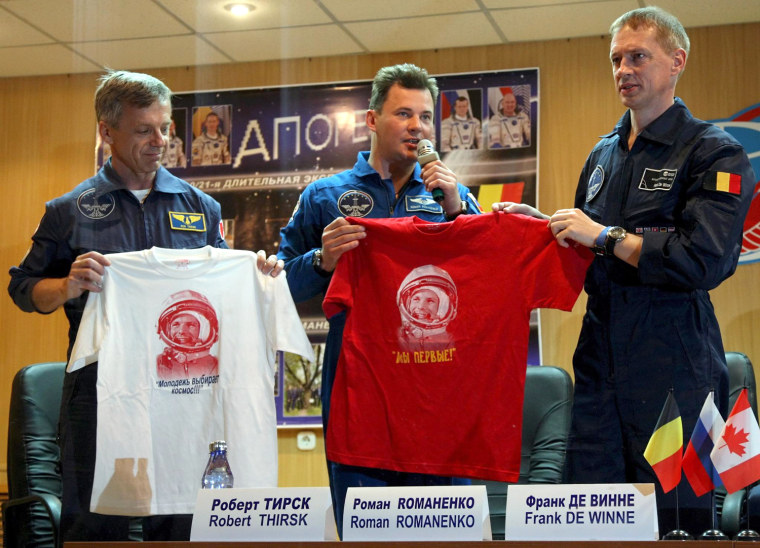After a decade of construction, the international space station will finally live up to its name this week when the first six-person crew takes up residence with astronauts from five different countries.
The second half of the station's inaugural six-member crew is poised to launch Wednesday morning aboard a Russian Soyuz rocket from Kazakhstan's Baikonur Cosmodrome. They will arrive on Friday morning to join the first wave of their crew already aboard the station.
When the new Soyuz crew joins the three astronauts already waiting on the orbiting laboratory, it will be the first time, ever, that all five of the station's international partner agencies (NASA, the Russian Federal Space Agency, the Japan Aerospace Exploration Agency, the European Space Agency and the Canadian Space Agency) — will be represented on orbit at once. It's fitting that the cosmic lineup coincided with the station's first six-person crew.
"At this time, we will have Canadian, Russian, American, European and Japanese guy on board space station, and I would say it's [an] outstanding event," Expedition 20 space station commander Gennady Padalka, a Russian cosmonaut, said in a preflight interview. "You know that all these countries have been participating in ISS project for 10 years as a minimum, and now it's pretty high time to have all these astronauts and cosmonauts together working in space."
Construction on the international space station began in 1998, with the first three-man tenants setting up shop in 2000, once living quarters arrived. Today, the station is home to Padalka, American astronaut Michael Barratt and Japanese astronaut Koichi Wakata.
On Wednesday, Russian cosmonaut Roman Romanenko will command the Soyuz TMA-15 spacecraft that will launch himself, Belgian astronaut Frank De Winne of ESA and Canadian astronaut Robert Thirsk.
"When we all get together at the table, we will see that we are people from all corners of the world, working together as a single team to execute our mission program, and I want to believe that we will be able to find a common language and that we will all be happy to be part of this family," Romanenko said in a NASA interview.
The astronauts will have more to drink at their dinner table. Last week, the station crew officially began consuming water recycled from their own urine and sweat, part of vital life support gear designed specifically to support a full six-person crew.
New arrivals
Romanenko, a former Russian air force pilot, will be making his first trip to space after joining the Russian space agency in 1997. He is married and has one son.
De Winne is a former test pilot for the Belgian air force and joined ESA in 2000. He is married and has three children. De Winne is a veteran of a 2002 Soyuz trip to the space station and is set to assume command of the Expedition 21 mission after Padalka flies home in October. When he takes the helm, he will become the first European station commander.
"This is the first for Europe that there will be an ESA astronaut commanding the international space station, and that's of course very important for ESA, our European agency, which has invested a lot in the international space station," De Winne said.
Thirsk was a medical doctor before he joined the CSA in 1983. In 1996, he flew on the space shuttle science mission STS-78, which was devoted to materials and life science research. He is Canada's first long-duration astronaut.
Getting crowded
Padalka, Barratt and Wakata on the station now are currently serving as the station's Expedition 19 crew. They will shift to Expedition 20, with Padalka still in charge, when their new crewmates arrive Friday.
"I think for us to expand our frontiers in space, international cooperation is essential," Wakata said in a preflight interview. "The ISS project has demonstrated that it's possible."
The members of the double-sized crew will have their work cut out for them, with a full schedule of research and space station maintenance planned. The international nature of the crew should also provide some fun chances for cross-cultural learning.
"We look at each other as much more as colleagues than ambassadors, but, at the same time, we're well aware that we represent nations and agencies and we want to serve the best interests of all of those as well," Barratt said in an interview. "We enjoy one another's food and company, and we just have a great time together."
The astronauts are prepared for some wrangling to take place as they try to adjust to a more crowded space station than they've been used to.
"The ground is doing a great job, and they try to take into account on all details, and they try to envisage all problems," Padalka said. "But, at the same time, we are ready to put up with some tiny problems and ready to work with the ground as one team to resolve them."
More science
With the start of large crews, the space station is entering a new phase where spacefliers hope to move beyond the basics of building the station, which has been the focus of most missions so far.
A major goal of the Expedition 20 mission is to "help transition the space station program from a phase that has been dominated by assembly, to one of utilization to help the station fulfill its new responsibility as a world-class facility for doing research and development," Thirsk said.
And if the space station starts to feel crowded when the first six-person crew arrives, wait until the space shuttle Endeavour visits during its June STS-127 flight.
"If you consider that the permanent crew will be six, a visiting shuttle will be seven, now we'll have up to 13 on the space station," Barratt said. "As far as I know, that's the most we've ever had on a single platform in space in history, so we'll look forward to seeing how all that works."
